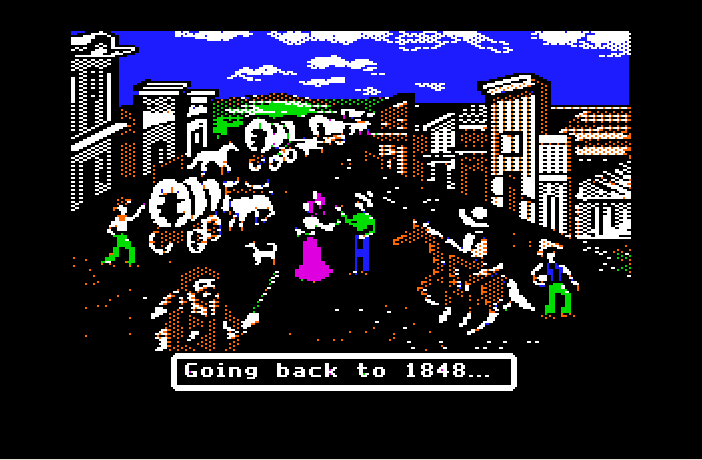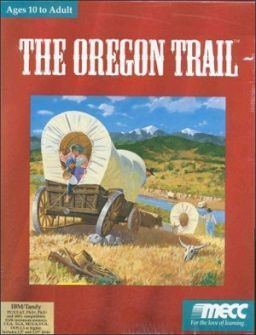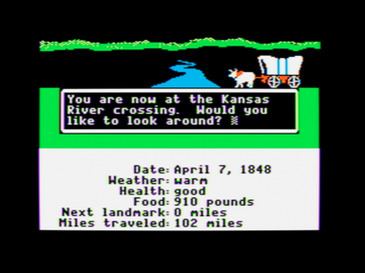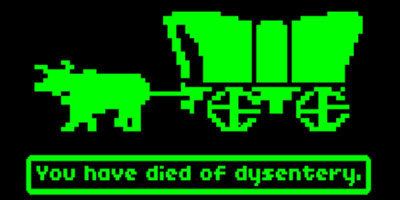6.6 /10 1 Votes
Initial release date 3 December 1971 Manufacturer The Learning Company | 3.3/5 Amazon Genre Simulation Developers Gameloft, MECC | |||||||||||||||||||||||||||||||||
 | ||||||||||||||||||||||||||||||||||
Platforms Android, Microsoft Windows, iOS, Nintendo 3DS, Wii Publishers Gameloft, MECC, The Learning Company, Brøderbund Software, Softswap Similar MECC games, Educational games | ||||||||||||||||||||||||||||||||||
The Oregon Trail is a computer game originally developed by Don Rawitsch, Bill Heinemann, and Paul Dillenberger in 1971 and produced by the Minnesota Educational Computing Consortium (MECC) in 1974. The original game was designed to teach school children about the realities of 19th century pioneer life on the Oregon Trail. The player assumes the role of a wagon leader guiding his or her party of settlers from Independence, Missouri, to Oregon's Willamette Valley on the Oregon Trail via a covered wagon in 1848.
Contents

The game is the first entry in the Oregon Trail series, and has since been released in many editions by various developers and publishers who have acquired rights to it, as well as inspiring a number of spinoffs (such as The Yukon Trail and The Amazon Trail) and the parody The Organ Trail.

The Oregon Trail was extremely successful, selling over 65 million copies, after ten iterations over forty years. It was included in the book 1001 Video Games You Must Play Before You Die. It was a hallmark in elementary schools worldwide from the mid-1980s to mid-2000s, as school computers came bundled with the game. In 2016, The Oregon Trail was inducted into the World Video Game Hall of Fame.

History

In 1971, Don Rawitsch, a senior at Carleton College in Northfield, Minnesota, taught an 8th grade history class as a student teacher. He used HP Time-Shared BASIC running on an HP 2100 minicomputer to write a computer program to help teach the subject. Rawitsch recruited two friends and fellow student teachers, Paul Dillenberger and Bill Heinemann, to help.

The Oregon Trail debuted to Rawitsch's class on December 3, 1971. Despite bugs, the game was immediately popular, and he made it available to others on Minneapolis Public Schools' time-sharing service. When the next semester ended, Rawitsch deleted the program, but he printed out a copy of the source code.
MECC
In 1974, the Minnesota Educational Computing Consortium (MECC), a state-funded organization that developed educational software for the classroom, hired Rawitsch. He rebuilt the game, adding events for choices based on the actual historical probabilities for what happened to travelers on the trail at each location in the game. He based much of the options in the game on historical narratives of people on the trail that he had read. Rawitsch uploaded The Oregon Trail into the organization's time-sharing network, where it could be accessed by schools across Minnesota. The game became one of the network's most popular programs, with thousands of players monthly.
Rawitsch published the source code of The Oregon Trail, written in BASIC 3.1 for the CDC Cyber 70/73-26, in Creative Computing's May–June 1978 issue. That year MECC began encouraging schools to adopt the Apple II microcomputer. John Cook adapted the game for the Apple II, and it appeared on A.P.P.L.E.'s PDS Disk series #108. A further version called Oregon Trail 2 was adapted in June, 1978 by J.P. O'Malley. The game was further released as part of MECC's Elementary series, on Elementary Volume 6 in 1980. The game was titled simply Oregon, and featured minimal graphics. It proved so popular that it was re-released as a standalone game, with substantially improved graphics, in 1985.
By 1995, The Oregon Trail comprised about one-third of MECC's $30 million in annual revenue. An updated version, Oregon Trail Deluxe, was released for DOS and Macintosh in 1992, as well as Windows in 1993 (under the title of simply The Oregon Trail Version 1.2) followed by Oregon Trail II in 1995, The Oregon Trail 3rd Edition in 1997, and 4th and 5th editions. As of 2011, more than 65 million copies of The Oregon Trail have been sold.
Editions
Travel
The game includes several landmarks along the trail where players can make decisions, shop for supplies or rest. These landmarks include: Kansas River, Big Blue River, Fort Kearney, Chimney Rock, Fort Laramie, Independence Rock, South Pass, Fort Bridger, Green River, Soda Springs, Fort Hall, Snake River, Fort Boise, Grande Ronde Valley in the Blue Mountains, Fort Walla Walla, and The Dalles. When approaching Oregon's Willamette Valley, travelers can either float a raft through the Columbia River Gorge or take the Barlow Road.
Hunting
An important aspect of the game was the ability to hunt. Using guns and bullets bought over the course of play, players select the hunt option (#8) and hunt wild animals to add to their food reserves. In the original version, there were no graphics and players were timed on how fast they could type "BANG," "WHAM," or "POW," with misspelled words resulting in a failed hunt. In the first full-graphics version, players controlled a little man who could aim a rifle in one of eight directions and fire single shots at animals. In later versions, players hunted with a cross-hair controlled by the mouse. Bison were the slowest moving targets and yielded the most food, while rabbits and squirrels were fast and offered very small amounts of food. Deer (eastern section) and elk (western section) were in the middle in terms of speed, size, and food yield; bears were between bison and deer in all three properties. While the amount of wild game shot during a hunting excursion is limited by only the player's supply of bullets, the maximum amount of meat that can be carried back to the wagon is 100 pounds in early versions of the game. In later versions, as long as there were at least two living members of the wagon party, 200 pounds could be carried back to the wagon. In the later version, players could hunt in different environments. For example, hunting during winter would result in graphics showing grass covered in snow. In later versions, the over-hunting of animals would result in "scarcity" and reduce the amount of animals that appeared later in the game.
Death
Throughout the course of the game, members of the player's party could fall ill and not rest, causing further harm to the victim. The party could die from various causes, such as measles, snakebite, dysentery, typhoid, cholera, and exhaustion. People could also die from drowning or accidental gunshot wounds. The player's oxen were also subject to illness and death. In the Oregon Trail 2/OT2 for PC and later releases, when a member of the player's party dies, the player has the option of conducting a brief funeral: If the player elects to do so (as the game's instructions and in-game advisers strongly recommend in all but the very harshest environments), the player may write a tombstone epitaph for the party member before continuing down the trail; if the player declines to hold a funeral, the party suffers a severe blow to morale.
Scoring
At the conclusion of the journey, a player's score is determined in two stages. In the first stage, the program awards a "raw" or unscaled number of points for each remaining family member (weighted by party health), each remaining possession (weighted by type), and remaining cash on hand (one point per dollar). In the second stage, the program multiplies this raw score by a "degree of difficulty" scalar corresponding to the party's initial level of resources (determined in-game by the profession of the party's leader); for example, in the Apple IIe game, a banker starting with $1600.00 receives no bonus, the final score of a carpenter starting with $800.00 is doubled, and the final score of a farmer starting with $400.00 is tripled.
Legacy
The game was popular among elementary school students worldwide from the mid-1980s to mid-2000s, as many computers came bundled with the game. MECC followed up on the success of The Oregon Trail with similar titles such as The Yukon Trail and The Amazon Trail. David H. Ahl published Westward Ho!, set on the Oregon Trail in 1847, as a type-in game in 1986.
The phrase "You have died of dysentery" has been popularized on T-shirts and other promotional merchandise. Another popular phrase from the game is "Here lies andy; peperony and chease," which is a player-generated epitaph featured on an in-game tombstone saved to a frequently bootlegged copy of the game disk, and likely a direct reference to a popular Tombstone pizza television commercial from the 1990s.
The game resurfaced in 2008 when Gameloft created an updated version for cell phones. A new release for the iPhone and iPod Touch is also available from Gameloft. The game went live in the iTunes App Store on March 11, 2009. On January 7, 2010, the Palm webOS version was released to the Palm App Catalog. On November 11, 2010, an Xbox Live version was released on Windows Phone 7.
The cell phone version of the game is similar to the original, but varies in that the player can choose one of three different wagons: A basic wagon, a prairie schooner or a Conestoga wagon. The player can also choose to become a banker, a carpenter, or a farmer, each of which has unique benefits. Unlike the computer version of the game, players in the iPhone and iPod Touch version do not need to buy guns and bullets. The game has received a major update, which had the player using trading and crafting to upgrade their wagon, buy food, and cure ailments.
In 2011 the 1975 and 1978 BASIC source code versions of the game were reconstructed.
On February 2, 2011, a new version of the game was released on the social networking site Facebook. This version was removed from Facebook when Blue Fang Games closed.
In 2012, a parody called The Organ Trail was released by the Men Who Wear Many Hats for browsers, iOS, and Android, with the setting changed to human survivors fleeing a zombie apocalypse.
In 2012, the Willamette Heritage Center (WHC) and the Statesman Journal newspaper in Salem, Oregon created Oregon Trail Live as a live-action event. Teams compete as they master 10 challenges on the grounds of the WHC. Challenges were based loosely on the game: hunting for game was done by shooting Nerf guns at college students wearing wigs and cloth antlers, while carrying 200 pounds of meat became pulling a 200-pound man up a hill in a child's red wagon while he recites historical meat facts and points out choice cuts. Independence, Missouri is at one end of the grounds and the Willamette Valley is at the other end. The WHC received the 2014 Outstanding Educator Award from the Oregon California Trails Association for this event.
In 2013, a dark comedy entitled Oregon Trail: The Play! received its first professional production by New Orleans-based theatre company, The NOLA Project and was subsequently published in 2016 by Alligator Pear Publishing, LLC. The play closely parodies the game, following a westward-headed family as they stock up on provisions for their oxen-led wagons and do their best to survive river crossings, illnesses, hunting, highway robbery, and a host of other mid-nineteenth century dilemmas. Audience members are asked to help provide food for the family in a mid-play nerf shooting gallery.
In 2014, a parody musical called The Trail to Oregon! was made by the musical theater company StarKid Productions, with several references being made towards the game.
In 2015, a 5k fun run held in Oregon City (the end of the route of the Oregon Trail) was modeled after the game with choice points along the route.
In 2016, the game was parodied in an episode of Teen Titans Go! entitled "Oregon Trail" (Season 3, Episode 48). In the episode, Robin forces his teammates to go on a real-life adventure on actual Oregon Trail complete with wagons and period clothing. During the episode, several aspects of the game are parodied and the game's text and options are parodied. Due to the hazards of the Trail, all of Robin's teammates die while Robin refuses to give up until he reaches Oregon. After finally reaching Oregon, his ghostly teammates ask Robin what he's learned and Robin reveals he has caught dysentery.
Also in 2016, Pressman Toy Corporation released The Oregon Trail card game based on the video game.
Reception
The game spawned many remakes, which received average to poor receptions. The Wii version obtained a 3 out of 10 from GameSpot, citing bland graphics, awkward controls and a confusing interface. Despite this, the reviewers stated that it could be a good educational tool. The game's iOS remake received a better reception, with a Metacritic score of 66/100. Multiplayer claimed the game was fun at first, but soon went downhill. They gave the game a 65/100.
Polygon described it as one of the most successful games of all time, calling it a cultural icon. IGN (in 2009) described the game as a "fond memory that will not let you down." Due to its widespread popularity, “The Oregon Trail” was inducted into World Video Game Hall of Fame in 2016. In 2012, The Oregon Trail was listed on Time's All-TIME 100 greatest video games list. In 2016, Time placed the game 9th on its The 50 Best Video Games of All Time list.
